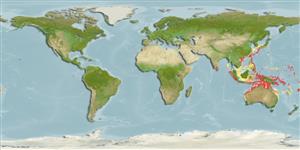Common names from other countries
>
Gobiiformes (Gobies) >
Gobiidae (Gobies) > Gobiinae
Etymology: Exyrias: Derived from Greek, xyreo = to shave (Ref. 45335); akihito: Named for the Emperor of Japan; noun in apposition..
More on authors: Allen & Randall.
Environment: milieu / climate zone / depth range / distribution range
Écologie
marin récifal; profondeur 10 - 50 m (Ref. 57733). Tropical
Western Pacific: Yaeyama Is., southern Japan to the Great Barrier Reef, Australia.
Taille / Poids / Âge
Maturity: Lm ? range ? - ? cm
Max length : 11.1 cm SL mâle / non sexé; (Ref. 57733)
Description synthétique
Clés d'identification | Morphologie | Morphométrie
Épines dorsales (Total) : 7; Rayons mous dorsaux (Total) : 10; Épines anales: 1; Rayons mous anaux: 9. Diagnosis: Color generally light bluish grey in life with small yellow to brownish orange spots on the head and body, those on body mostly conjoined to form longitudinal stripes along scale rows; 4 pairs of dark brown spots on lower side of body, followed by a single spot at the caudal-fin base; a few smaller dark brown spots on body, mostly in a row dorsally and one ventrally; dorsal and caudal fins are covered with numerous, relatively large, orangish to yellowish brown spots. Pectoral rays 17; segmented caudal-fin rays 17; branched caudal-fin rays typically 13, rarely 12, 14 or 15; dorsal-fin spines elongate and filamentous, the second one the longest 1.59-2.07 in SL. Longitudinal scale series 28 (28-30).
Usually found in clear water in the vicinity of coral reefs, usually on sand or rubble bottoms (Ref. 57733). Solitary (Ref. 90102).
Life cycle and mating behavior
Maturities | Reproduction | Spawnings | Egg(s) | Fecundities | Larves
Allen, G.R. and J.E. Randall, 2005. Exyrias akihito, a new species of coral-reef goby (Gobiidae) from the Western Pacific. Raffles Bull. Zool. 53(2):231-235. (Ref. 57733)
Statut dans la liste rouge de l'IUCN (Ref. 130435)
CITES (Ref. 128078)
Not Evaluated
Menace pour l'homme
Harmless
Utilisations par l'homme
Outils
Articles particuliers
Télécharger en XML
Sources Internet
Estimates based on models
Preferred temperature (Ref.
115969): 25.3 - 28.9, mean 27.7 (based on 290 cells).
Phylogenetic diversity index (Ref.
82804): PD
50 = 0.5312 [Uniqueness, from 0.5 = low to 2.0 = high].
Bayesian length-weight: a=0.01023 (0.00477 - 0.02194), b=3.02 (2.84 - 3.20), in cm Total Length, based on LWR estimates for this (Sub)family-body shape (Ref.
93245).
Niveau trophique (Ref.
69278): 3.1 ±0.4 se; based on size and trophs of closest relatives
Résilience (Ref.
120179): Haut, temps minimum de doublement de population inférieur à 15 mois (Preliminary K or Fecundity.).
Fishing Vulnerability (Ref.
59153): Low vulnerability (10 of 100).
